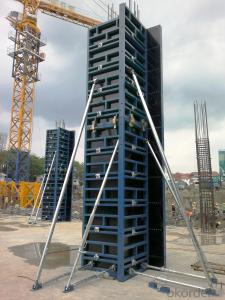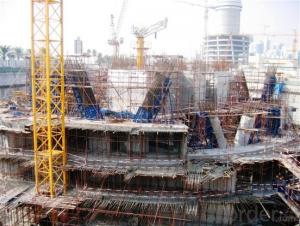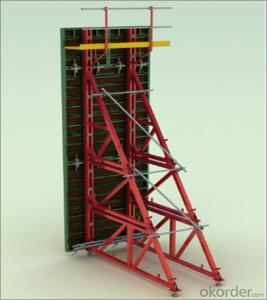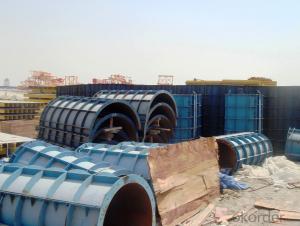Tabel Formwork system
- Loading Port:
- China Main Port
- Payment Terms:
- TT OR LC
- Min Order Qty:
- -
- Supply Capability:
- -
OKorder Service Pledge
Quality Product, Order Online Tracking, Timely Delivery
OKorder Financial Service
Credit Rating, Credit Services, Credit Purchasing
You Might Also Like
Tabel Formwork:
Table formwork is the most typical application for slab, with timber beam, the slab formwork is
light weight, fast and economic in the construction.
Characteristics:
◆ Simple structure, easy assembly.
◆ Flexible structure, be adapted to different support system.
◆ High construction efficiency with special system tools.
1. Lifting fork for lifting the table formwork to upper floor.
2. Trolley for moving the table formwork on floor.
◆ Flexible application with stand alone props.
◆ Safer condition with handrails.
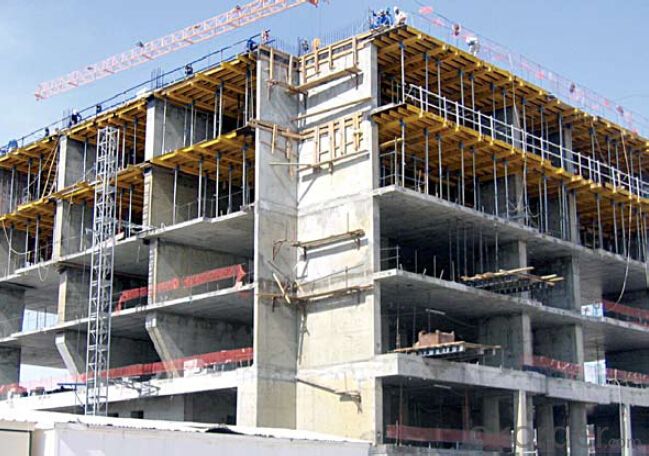
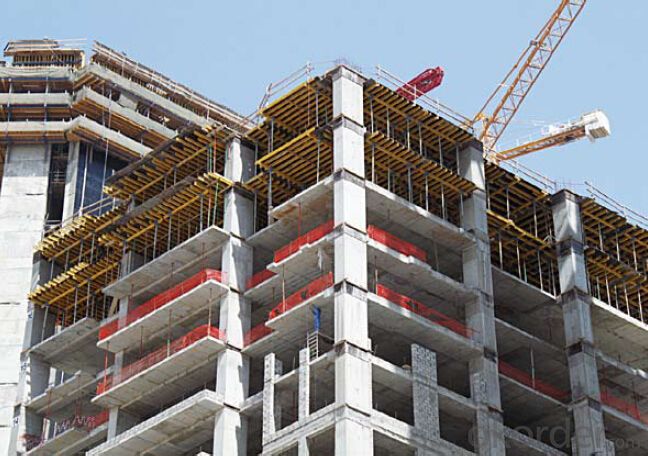

- Q:How does steel frame formwork handle different types of formwork joint arrangements?
- Steel frame formwork is a versatile and robust system that can handle different types of formwork joint arrangements with ease. This type of formwork is designed to be adjustable and flexible, allowing for various configurations and combinations of joints. One common type of formwork joint arrangement is the butt joint, where two formwork panels meet end-to-end. Steel frame formwork is designed with special connectors and clamps that securely hold the panels together, ensuring a tight and seamless joint. These connectors are adjustable, allowing for precise alignment of the panels to achieve the desired formwork shape and dimensions. Another type of joint arrangement is the corner joint, where two formwork panels meet at a 90-degree angle. Steel frame formwork is equipped with corner connectors that securely hold the panels together at the desired angle. These connectors are adjustable as well, allowing for precise alignment and ensuring a strong and stable corner joint. In addition to butt and corner joints, steel frame formwork can also handle other types of joint arrangements such as T-joints, cross joints, and Y-joints. The adjustable connectors and clamps of steel frame formwork enable easy assembly and disassembly of the panels, making it possible to create various joint configurations as required by the specific formwork design. Furthermore, steel frame formwork provides excellent stability and load-bearing capacity, making it suitable for handling different types of joint arrangements even in complex and demanding construction projects. The steel frames and panels are designed to withstand the pressure and forces exerted during the concrete pouring and curing process, ensuring the integrity and strength of the formwork joints. Overall, steel frame formwork is a reliable and efficient system that can handle different types of formwork joint arrangements. Its adjustable connectors and clamps, along with its stability and load-bearing capacity, make it a preferred choice for various construction applications.
- Q:Can steel frame formwork be used in combination with post-tensioning techniques?
- Yes, steel frame formwork can be used in combination with post-tensioning techniques. Post-tensioning is a method used to reinforce concrete structures by placing steel tendons within the concrete and then applying tension to the tendons after the concrete has cured. This technique can help increase the strength and durability of the structure. Steel frame formwork, on the other hand, is a system used to create the temporary molds or forms into which concrete is poured to create the desired shape of a structure. It consists of steel frames, panels, and accessories that are assembled on-site. When using post-tensioning techniques, the steel tendons are usually placed within the concrete before the formwork is erected. The steel frame formwork can be designed and adjusted to accommodate the tendons and ensure that they are properly positioned within the concrete. Additionally, steel frame formwork provides the necessary support and stability during the post-tensioning process. The formwork system can withstand the forces generated by the tensioning of the tendons without deforming or collapsing, ensuring that the concrete remains in the desired shape and position. Therefore, steel frame formwork can indeed be used in combination with post-tensioning techniques, providing an efficient and effective solution for constructing reinforced concrete structures.
- Q:Can steel frame formwork be used for both internal and external concrete walls?
- Yes, steel frame formwork can be used for both internal and external concrete walls. The steel frame provides strength and stability, making it suitable for various construction applications. Additionally, the formwork can be easily adjusted and reused, making it a cost-effective solution for both internal and external walls.
- Q:Can steel frame formwork be used for both interior and exterior wall construction?
- Yes, steel frame formwork can be used for both interior and exterior wall construction. Steel frame formwork is a versatile and durable system that is commonly used in construction applications. It provides a stable framework for pouring concrete and allows for the creation of straight and smooth walls. The steel frame formwork can be easily adjusted and repositioned, making it suitable for both interior and exterior wall construction. Additionally, the steel frame formwork is designed to withstand the pressure exerted by wet concrete, ensuring that the walls will be strong and stable after the concrete has cured.
- Q:Are there any specific considerations for using steel frame formwork in industrial construction projects?
- Yes, there are several specific considerations for using steel frame formwork in industrial construction projects. Firstly, steel frame formwork offers high strength and durability, making it suitable for large-scale and heavy-duty applications commonly found in industrial projects. Additionally, steel formwork provides excellent dimensional accuracy, ensuring precise and consistent results. It is also fire resistant, which is crucial in industrial settings where fire safety is a priority. Furthermore, steel formwork is reusable, reducing overall project costs and environmental impact. However, it is important to note that steel formwork requires skilled labor and proper maintenance to ensure its longevity and optimal performance.
- Q:How does steel frame formwork handle different types of concrete shrinkage?
- Steel frame formwork is highly effective in handling different types of concrete shrinkage. The steel frame provides strong support and stability, reducing the risk of deformation or cracking due to shrinkage. Additionally, the adjustable nature of steel frame formwork allows for precise control over the concrete pouring process, enabling contractors to account for and minimize the effects of shrinkage. Overall, steel frame formwork ensures the structural integrity and durability of concrete structures, even in the face of various shrinkage patterns.
- Q:What are the different surface finishes that can be achieved using steel frame formwork?
- Some different surface finishes that can be achieved using steel frame formwork include smooth surfaces, textured surfaces, exposed aggregate finishes, and various patterns or designs.
- Q:How does steel frame formwork accommodate for different concrete curing methods?
- The use of steel frame formwork in construction offers great flexibility in accommodating various concrete curing methods. It allows for the utilization of different curing materials, including water, steam, or chemicals, depending on the desired outcome. This is made possible by the strong and resilient nature of steel, which can withstand the extreme temperatures and pressures associated with steam curing, as well as the corrosive effects of certain chemicals. Furthermore, steel frame formwork can be easily adjusted or modified to create different curing environments. For instance, if a particular section of the concrete structure requires accelerated curing, temporary enclosures can be constructed using steel panels to retain the necessary heat and moisture for faster curing. On the other hand, if a slower curing method is preferred, the steel formwork can be designed to allow for increased ventilation and air circulation, promoting natural air curing. Moreover, steel frame formwork offers a high level of customization, allowing for the integration of various curing systems or equipment. For example, heating elements or pipes can be embedded within the formwork to provide controlled heating or cooling during the curing process. This is especially advantageous in situations where a specific temperature range needs to be maintained for optimal concrete strength development. Additionally, the reusability of steel frame formwork is a significant advantage. It can be easily disassembled and reassembled for different projects or sections of a structure. This feature allows for the implementation of different curing methods based on specific project requirements or resource availability. In conclusion, steel frame formwork is a versatile construction technique that can accommodate a wide range of concrete curing methods. Its durability, adaptability, customizability, and reusability make it an ideal choice for meeting various curing requirements, whether they involve water, steam, chemicals, accelerated curing, or natural air curing.
- Q:What are the key considerations for selecting the appropriate steel frame formwork system for repetitive use?
- When selecting the appropriate steel frame formwork system for repetitive use, there are several key considerations that need to be taken into account. Firstly, the durability and quality of the steel frame formwork system is of utmost importance. Since it will be used repetitively, it needs to withstand the constant wear and tear without compromising its integrity. The steel used should be of high quality and have the necessary strength and toughness to withstand the repetitive loads. The ease of assembly and disassembly is another crucial factor to consider. The formwork system should be designed in such a way that it can be easily assembled and disassembled without requiring excessive time or effort. This will not only save time during construction but also make it more efficient for repetitive use. Additionally, the adjustability and flexibility of the formwork system should be considered. It should be capable of accommodating different sizes and shapes of concrete structures. This adaptability is crucial as it allows for versatility in construction projects and ensures that the formwork system can be reused for various purposes. Furthermore, the safety features of the steel frame formwork system should be thoroughly evaluated. It should have adequate bracing and support to ensure stability during the concrete pouring process. It should also have proper guardrails and safety measures in place to protect workers from potential hazards. The cost-effectiveness of the formwork system is another key consideration. While it is important to select a reliable and durable system, it is equally important to ensure that it offers value for money. Comparing the initial investment with the expected lifespan and number of reuses can help determine the cost-effectiveness of the system. Lastly, the availability of technical support and maintenance services should be considered. It is essential to choose a manufacturer or supplier that provides adequate technical support and maintenance services throughout the lifespan of the formwork system. This ensures that any issues or repairs can be addressed promptly, minimizing downtime and maximizing the system's longevity. By considering these key factors, one can select the appropriate steel frame formwork system that is durable, easy to assemble and disassemble, adjustable, safe, cost-effective, and backed by reliable technical support and maintenance services.
- Q:Can steel frame formwork be used in areas with limited space for storage?
- Indeed, areas with limited storage space can utilize steel frame formwork. Its versatility and compactness are well-known, rendering it appropriate for projects with restricted storage capacity. Unlike conventional formwork systems, steel frame formwork can be effortlessly disassembled and reassembled, enabling efficient utilization of storage space. Furthermore, its lightweight nature and ease of transportation enhance its suitability for areas with limited storage capability. In summary, steel frame formwork proves to be a pragmatic and flexible solution for construction projects in confined spaces.
1. Manufacturer Overview |
|
|---|---|
| Location | |
| Year Established | |
| Annual Output Value | |
| Main Markets | |
| Company Certifications | |
2. Manufacturer Certificates |
|
|---|---|
| a) Certification Name | |
| Range | |
| Reference | |
| Validity Period | |
3. Manufacturer Capability |
|
|---|---|
| a)Trade Capacity | |
| Nearest Port | |
| Export Percentage | |
| No.of Employees in Trade Department | |
| Language Spoken: | |
| b)Factory Information | |
| Factory Size: | |
| No. of Production Lines | |
| Contract Manufacturing | |
| Product Price Range | |
Send your message to us
Tabel Formwork system
- Loading Port:
- China Main Port
- Payment Terms:
- TT OR LC
- Min Order Qty:
- -
- Supply Capability:
- -
OKorder Service Pledge
Quality Product, Order Online Tracking, Timely Delivery
OKorder Financial Service
Credit Rating, Credit Services, Credit Purchasing
Similar products
New products
Hot products
Related keywords




















